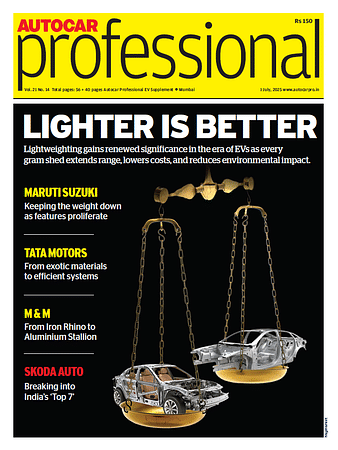'Indian OEMs are rising up to the challenge of lightweighting and closing the gap with their global counterparts.'
Nitin Bahl, director, Radiant Polymers speaks to Amit Panday on Indian OEMs taking to the lightweighting mantra.
Nitin Bahl, director, Radiant Polymers speaks to Amit Panday on Indian OEMs taking to the lightweighting mantra.
How open are Indian OEMs when it comes to adopting vehicle lightweighting compared to their global counterparts?
At the moment, global OEMs are progressing faster in adopting lightweighting technologies due to their strong R&D and engineering capabilities.
Indian OEMs are also rising up to the challenge and closing this gap with their global counterparts.
How are the cost pressures dealt with while chasing weight reduction and similar technologies?
Typically every technology accompanies a heavy investment in tooling and related machine / equipment infrastructure and lightweighting technology is no exception here. However, OEMs try to amortise the required investments on high volumes and multiple projects so that the business case is validated.
There are cases in which lightweighting may result in cost up as well at a component level, but OEMs still go ahead due to advantages of fuel efficiency and power to width ratio. A fuel tank is an example of such an innovation.
What are the top three key areas within technologies surrounding polymers to cut down vehicle weight in a cost effective way?
The three key areas within the gamut of plastics are:
• Development of polymer-based solution which helps in better integration (with metals and electronics) and reduction of number of components. For example, components such as the fuel tank, air intake manifold and others provide a good scope for the same.
• Using different types of polymer-based material reinforced with additives (such as carbon, glass and others).
• Density reduction by chemical foaming process.
In the consistently changing environment, what kind of shelf life does the current polymer-based solution have? For example, a fuel tank.
Polymer solutions offer better shelf life in comparison to conventional material. We can define this by taking an example of a plastic fuel tank. A polymer-based fuel tank offers significant performance in terms of fuel vapour emissions as it has 6-7 layers which not only reduces permeability but also improves impact resistance. Further, it offers better integration of associated child parts in comparison to conventional sheet metal tanks as the same can be incorporated in the moulding process.
RELATED ARTICLES
India: A Bastion Of Stability for Schaeffler
German autoparts maker Schaeffler’s CEO, Klaus Rosenfeld, describes India’s role in the company’s €24-25 billion empire....
'No Question of Us Being Late' - Suzuki India on e-2Wheeler Market
Suzuki Motorcycle India believes its EV entry is timely as the market is now mature enough to grow off genuine demand ra...
'India Can Become a Major Pillar for Us' - Marquardt Group
Björn Twiehaus, CEO of Marquardt Group, and Vishal Narvekar, the company's India GM, share their outlook on the Indian m...





 02 May 2014
02 May 2014
 6264 Views
6264 Views





 Ketan Thakkar
Ketan Thakkar


 Angitha Suresh
Angitha Suresh

 Darshan Nakhwa
Darshan Nakhwa

